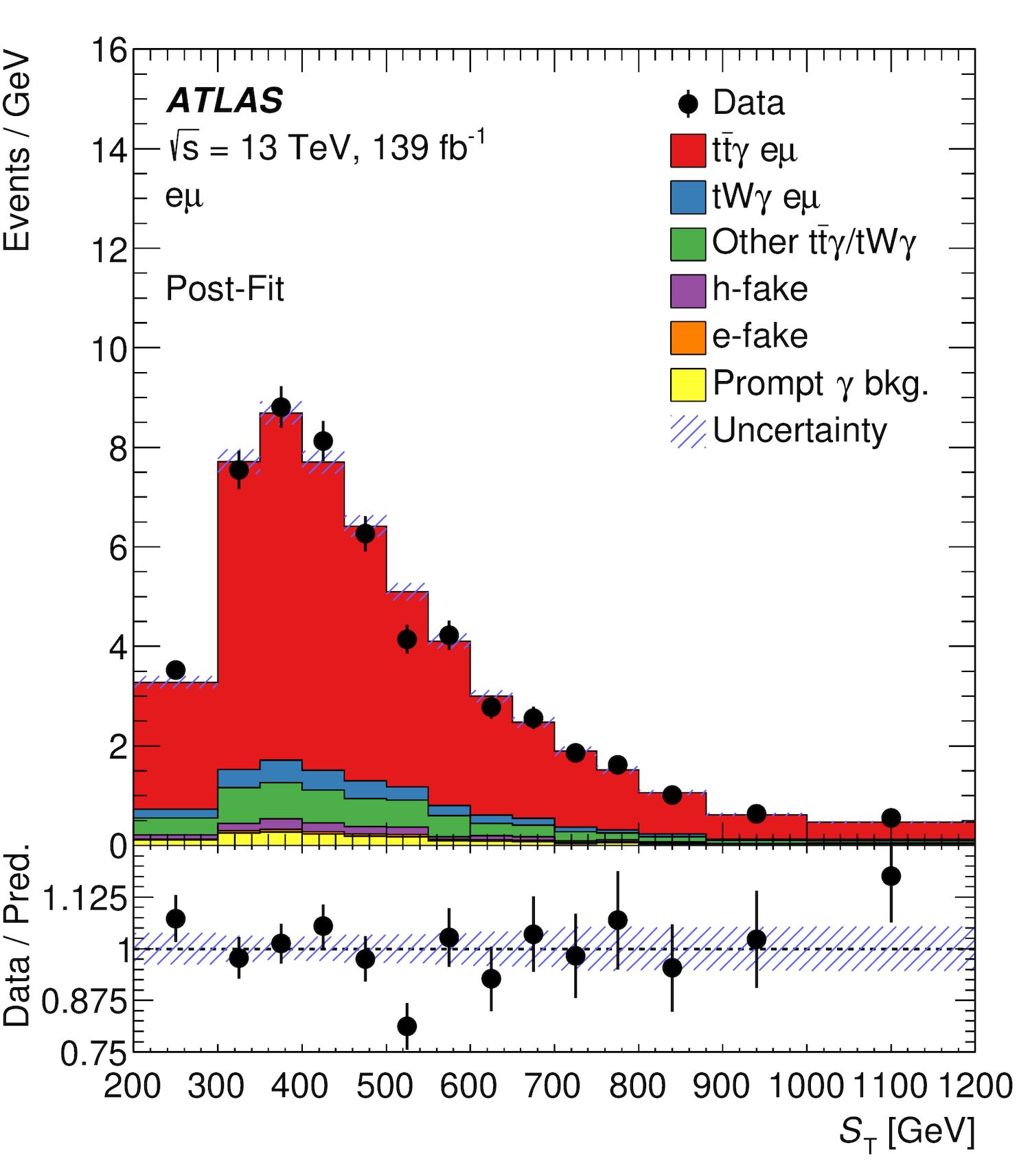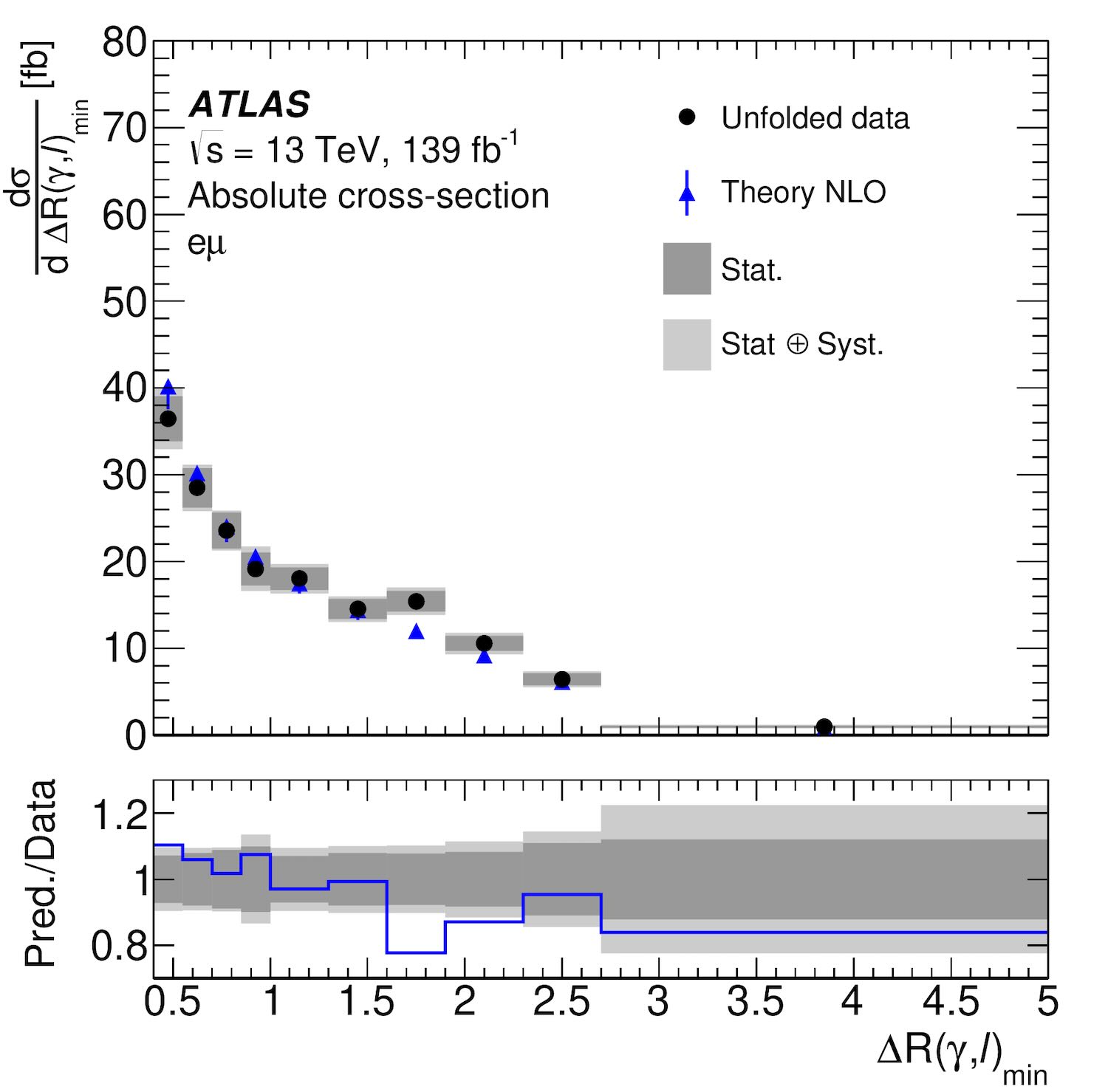At the Large Hadron Collider (LHC) at CERN, physicists delve into the fundamental building blocks of matter and the forces that govern them. Among the most fascinating particles is the top quark, the heaviest known elementary particle. Studying how top quarks interact with other particles, including photons, provides crucial insights into the Standard Model of particle physics and can even hint at the existence of new physics phenomena.
Our work from the ATLAS Collaboration, published in 2020 in the Journal of High Energy Physics (JHEP), presents comprehensive measurements of the combined production of top-quark pairs with a photon (ttγ) and a single top quark with a W boson and a photon (tWγ). These processes are particularly interesting because they allow us to probe the electroweak coupling of the top quark and search for potential deviations from Standard Model predictions that could signal new physics.
This analysis builds upon previous efforts by using the full dataset recorded by the ATLAS detector between 2015 and 2018, corresponding to an integrated luminosity of 139 fb⁻¹. We focused on events in the electron-muon (eμ) channel, which offers a clean final state with relatively small background contributions. This allowed us to perform precise measurements without relying on complex multivariate analysis techniques for signal-background separation.
Crucially, this measurement is performed at the parton level, enabling direct comparison with state-of-the-art theoretical calculations (G. Bevilacqua et al., JHEP 10 (2018) 158, JHEP 01 (2019) 188). We measured both the inclusive cross-section and differential cross-sections as functions of various kinematic variables of the photon and leptons. These detailed measurements provide a stringent test of theoretical models and contribute to our understanding of these fundamental interactions.
Here are example Feynman diagrams illustrating these processes:
 Figure: Example Feynman diagrams at leading order for tt̄γ (left) and tWγ production (right) in the eμ channel. The top-quark mass resonances are marked with double-lined arrows, while W bosons are shown in red. (Image: ATLAS Collaboration/CERN)
Figure: Example Feynman diagrams at leading order for tt̄γ (left) and tWγ production (right) in the eμ channel. The top-quark mass resonances are marked with double-lined arrows, while W bosons are shown in red. (Image: ATLAS Collaboration/CERN)
The Experimental Approach: Sifting Through Collisions
To perform this measurement, we meticulously selected events recorded by the ATLAS detector that matched the signature of ttγ or tWγ production in the eμ channel. This involved identifying exactly one electron and one muon with opposite charges, at least two jets (with at least one b-tagged jet), and precisely one photon. All selected particles had to meet strict quality and kinematic criteria to ensure their reliable reconstruction.
Signal and Background Modelling
Understanding both the signal (ttγ and tWγ production) and various background processes is paramount for an accurate measurement. We relied on sophisticated Monte Carlo simulations to model these processes. These simulations account for the complex interactions within the LHC and the response of the ATLAS detector. A key aspect of our modelling involved carefully handling photons: some simulations intrinsically produce photons (dedicated simulations), while others produce them stochastically through radiation (inclusive simulations). A rigorous overlap-removal procedure was applied to avoid double-counting and ensure consistency.
Background processes were categorized based on the origin of the reconstructed photon: hadronic fakes (where a hadron mimics a photon), electron fakes (where an electron is misidentified as a photon), and genuine prompt photons from other Standard Model processes. Each of these backgrounds was carefully estimated and accounted for in the analysis.
Measuring the Inclusive Cross-Section
To determine the overall rate of ttγ and tWγ production, we performed a profile likelihood fit to the distribution of a variable called ST. ST is defined as the scalar sum of the transverse momenta of all reconstructed objects in the event (leptons, photons, jets, and missing transverse momentum). This variable proved to be effective in separating signal from background and was less sensitive to systematic uncertainties compared to other kinematic distributions.
The fit allowed us to extract the fiducial inclusive cross-section, which represents the production rate within a specific, well-defined region of the detector’s acceptance. This fiducial region is chosen to closely mimic the conditions of theoretical calculations, allowing for direct comparison. The measured cross-section was found to be in good agreement with the latest theoretical predictions at next-to-leading order (NLO) in Quantum Chromodynamics.
Here’s a look at the post-fit distribution of the ST variable:
 Figure: Post-fit distribution of the ST variable. The uncertainty band represents the post-fit uncertainties. Underflow and overflow events are included in the first and last bins. The lower panel shows the ratio of the data to the prediction. (Image: ATLAS Collaboration/CERN)
Figure: Post-fit distribution of the ST variable. The uncertainty band represents the post-fit uncertainties. Underflow and overflow events are included in the first and last bins. The lower panel shows the ratio of the data to the prediction. (Image: ATLAS Collaboration/CERN)
Unveiling Differential Cross-Sections
Beyond the overall production rate, we also measured differential cross-sections. These measurements provide more granular information by showing how the production rate varies as a function of specific kinematic variables. We looked at variables such as the photon’s transverse momentum and pseudorapidity, as well as angular separations between the photon and leptons. These differential measurements are particularly sensitive to the underlying dynamics of the interaction and can reveal subtle effects not visible in the inclusive measurement.
To obtain these differential cross-sections, we corrected the observed data for detector effects (like resolution and acceptance) using an iterative unfolding procedure. This process effectively reconstructs the true parton-level distributions from the detector-level observations. The measured differential cross-sections were then compared with both NLO theoretical calculations and various Monte Carlo simulations.
Our findings show that the shapes of the measured differential distributions are generally well described by both the leading-order Monte Carlo predictions and, even better, by the NLO theory prediction. This agreement provides strong validation of our understanding of these complex processes.
One particularly interesting observable is the minimum angular separation, ΔR, between the photon and a lepton. This variable is sensitive to the angle between the top quark and the radiated photon, offering insights into the structure of the tγ coupling. Here’s how the data compares to predictions for this variable:
 Figure: Normalised differential cross-section as a function of the minimum ΔR between the photon and a lepton. Data are compared with an NLO Quantum Chromodynamics calculation. The lower panel shows the ratio of prediction to data. (Image: ATLAS Collaboration/CERN)
Figure: Normalised differential cross-section as a function of the minimum ΔR between the photon and a lepton. Data are compared with an NLO Quantum Chromodynamics calculation. The lower panel shows the ratio of prediction to data. (Image: ATLAS Collaboration/CERN)
Systematic Uncertainties: Quantifying Our Confidence
In any precision measurement in particle physics, a thorough understanding and quantification of systematic uncertainties are crucial. These uncertainties arise from various sources, including experimental factors (like detector calibration, object reconstruction efficiencies, and energy scales) and theoretical modelling uncertainties (related to the choice of Quantum Chromodynamics scales, parton shower models, and parton distribution functions).
We evaluated the impact of each systematic uncertainty on both the inclusive and differential cross-section measurements. For the inclusive cross-section, these uncertainties were incorporated into a profile likelihood fit. For the differential measurements, each uncertainty was determined individually for each bin of the measured distribution. The dominant sources of systematic uncertainty were found to be related to the modelling of the signal and background processes.
Conclusion: A Step Forward in Understanding Top-Quark Physics
This comprehensive analysis by the ATLAS Collaboration provides precise measurements of the combined ttγ and tWγ production cross-sections in the eμ decay channel at 13 TeV. Our results, based on the full Run 2 dataset, are in excellent agreement with state-of-the-art NLO theoretical predictions. This agreement not only validates our understanding of these fundamental processes but also demonstrates the remarkable precision achieved by the ATLAS experiment.
These measurements contribute significantly to the ongoing program of top-quark physics at the LHC. By probing the electroweak coupling of the top quark and providing detailed differential distributions, we lay the groundwork for future searches for new physics and further refinements of the Standard Model. This work exemplifies the collaborative effort within the ATLAS Collaboration to push the boundaries of high-energy physics research.
Publication:
Author: ATLAS Collaboration.
Title: Measurements of inclusive and differential cross-sections of combined tt̄γ and tWγ production in the eμ channel.
Reference: JHEP 09 (2020) 049.
DOI:10.1007/JHEP09(2020)049
|
arXiv:2007.06946.